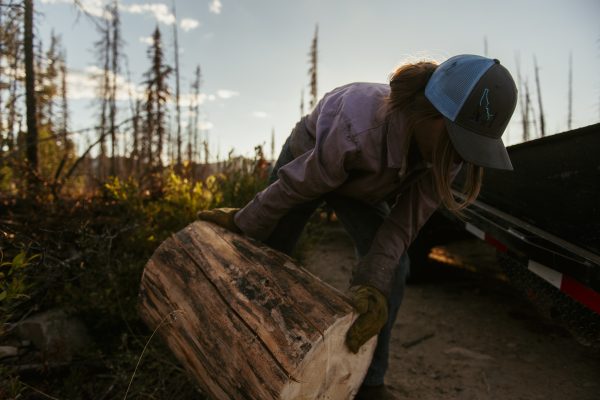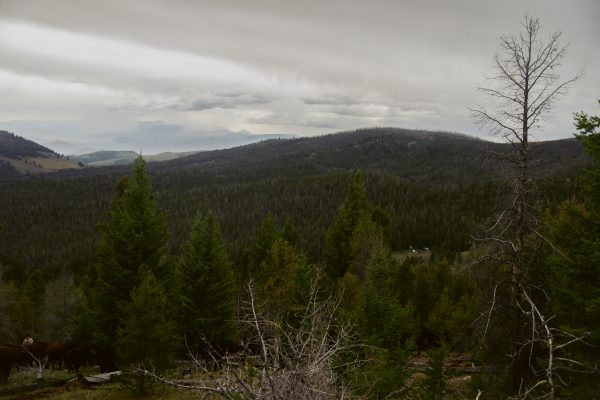
I recall one time in the 80s when I was leading a crew out one of my prescribed fires when the wind picked up unexpectedly. A few of us were up a steep mountainside monitoring our exposed mineral soil fireline, and jumping on windborne embers that strayed over the line to prevent fire spread further up the mountain.
Things were really quiet until a large thunderhead came over and made the wind pick up. Suddenly, 3 foot flame lengths turned into 30 footers heading towards us fast. Our line was an old logging road, and we were able to hunker down along the cutbank of the road, under the rolling smoke and searing heat and flame, bandanas over our faces to keep the dirt from our lungs as we tried to pull our breath from the cool dirt.
Our Nomex clothes and retardant pack gear protected us from sparks, and soon, as I expected, the short-lived wind abated, and we were back to extinguishing spot fires that had crossed the line. As we inhaled deeply of the now available air, Tracy, one of the women on the line told me she was 3 months pregnant. I looked at her blankly while the thought set in. She said she needed the good money that fire overtime brings, and begged me not to tell anyone. There weren’t any rules against being a pregnant firefighter, after all. I moved her to a non-smoky upwind spot (she had a healthy boy 6 months later that I still see around town).
If that fire behavior would have been at all sustained there would be no options for human intervention. We would have pulled—hence the term “wild” fire, as it would have been uncontrollable in those conditions. That’s what’s happening through much of the West right now. There is very little to be done, until weather cooperates. Snowfall will happen eventually.
It’s a pretty tough deal for Ed Wilsey, as just a week before, he and his neighbors had announced they were giving up on the grass fed beef label they had worked hard to develop. Together, they decided to disband their Homestead Beef label product line and quit the direct marketing of their product to stores, restaurants, and the internet, closing their doors at the end of August. Apparently, the commercial beef cattle market was too high to pass up, and their branded program was not cash flowing for all the time and money it took to market it.
They are not the only ones. Several of Alderspring’s largest competitors had already thrown in the towel over the past couple years, hanging it up after years of developing a relationship-based customer following. Even Joel Salatin, of Virginia’s Polyface farms, known widely as the grass fed pioneer through the growing and marketing of his “Salad Bar Beef” stated late last year in a column in their blog that “Right now, today, Polyface would make more money selling our finished beeves to the industrial food system than direct marketing to our customer families.”
The same is true for us, at Alderspring. We could clear much more money selling our organic production on the commodity market (completely ignoring all the work we did to make them organic) than through our webstore. How can this be?
First, it has to do with the price of purchased calves from our partners. Joel Salatin purchases half of his stock from neighbors in Virginia. Along with the ones we home raise, Alderspring also purchases calves from 3 producers in Montana and Idaho who we found that share our ideals: certified organic, raised on wild rangelands, ancient genetics that yield well on wild grass, family owned and operated, 100% grass fed, and kindly (that’s more than humanely, btw) raised.
We keep them for an average of 12 months to get “Alderspring”into them; that means not only flavor and tenderness from our soils and grass, but also our “counseling” program that gets them even further quiet in human presence (they are prey animals, after all).
It wouldn’t be fair to us to ask these rancher friends to take less than they could get on the commodity market, especially after all the work they did with those attributes like organic that I mentioned above.
Second, current beef prices in the store don’t really reflect the cost of beef. For the first time we can remember, the cow-calf producer is doing pretty well, but all other sectors of the beef chain are taking it in the shorts. Beef retail prices have been steadily increasing, but still lag behind the value of that beef on the open commercial live market. Because we are little guys without big deep pockets, we have to calculate our costs with a shorter time frame.
Third, our artisanal processing costs are about 8 times more expensive than commodity beef. Commodity beef is processed at factory kill rate average of over 200 head per hour (some plants as high as 400 animals per hour). Our beef is processed at the rate of about 4 per hour—a snail’s pace in comparison. At our plant, everything is done by hand, as opposed to a high speed factory line. Our beef is inspected by a USDA inspector just like the big plants (I’ll bet those inspectors like it when their rotation comes up for our small, less stressful, processing plant). USDA regulatory record keeping and process is exactly the same, regardless of scale.
As a result all economic incentives are to scale up tremendously, which is why most beef in the U.S. is finished in huge feedlots and processed in huge plants. This simply doesn’t fit with the humane handcrafted product that we produce.
So”¦we are stuck with razor-thin margins for now. But we’ve been at this for years; 22 to be exact, and are in it for the long haul.
“‹
I think it has to do with our blood- Dutch thriftiness and tenacity runs thick through both Caryl and my veins. Remember that our forebears were crazy and stubborn enough to build a dry nation out of seafloor. My parents left post-war Holland with $64 to their name and through grit and stubbornness made a life here.
Caryl and I really believe in serving up our wild wellness (which unsurprisingly also happens to be the best eating beef). It is an art and science that is almost completely lost, even globally, and we hope to reconstruct at least an option from the “de-beefication” of beef to offer people a prehistorically wild food. Passion and a sense of “rightness” drives us on.
Feedlots and even grass fed monoculture producers have completely changed the wild nature of beef. A few days ago I saw an online ad where one of the largest grass fed online purveyors proudly announced that they were finishing their beef by grazing a monoculture of farmed millet. De-beefication: the loss of flavor, and wellness via a complete loss in nutrition density and grass diversity. Cost cutting”¦at the expense of quality.
So, when you see other grass fed and organic producers calling it quits, don’t worry about us. Commodity beef will go down, and we’ll be profitable again. And hopefully we have enough bottom and cost cutting savvy (not quality cutting savvy, btw) to wait economics out. At least our young-adult daughters qualify quite handily for college-aiding Pell Grants!
We’re going to stick with what we do. Thanks for walking with us!







Leave a Reply